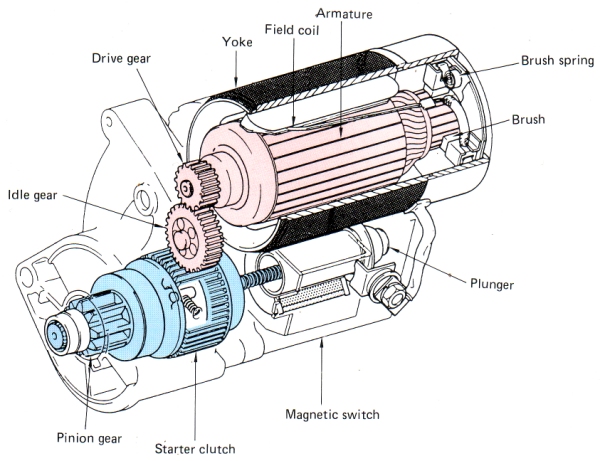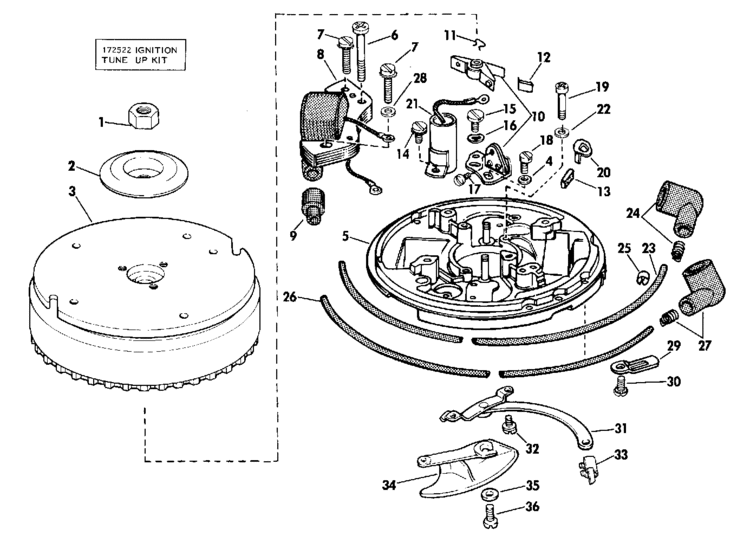A starter motor is a high torque electric motor that is tasked with cranking over the engine to start up the process of combustion and running of the engine. Prior to starter motors engines were hand cranked to start which was an arduous process. They are feed power from the battery and different types have emerged over the years.
Inertia:
An inertia starter motor refers to the way that the drive pinion is engaged. The drive pinion slides freely up and down on a worm gear on the spline, when the motor is engaged the rotation of the armature drives the pinion up the spline and engages the pinion into the teeth on the ring of the flywheel, which in turn cranks the engine. when the key is released the momentum of the flywheel drives the pinion the opposite direction and the pinion goes back down the spline into the neutral position. Advantages are the inertia drives simplicity and ease of function, the disadvantages are that the drive pinion can wear and possibly damage the ring gear on the flywheel as the pinion is driven into the flywheel at high speed, it is also noisy.
Pre engaged starter motor:
A pre engaged starter motor is an improvement on the inertia starer motor. A solenoid attached by a lever to the drive pinion acts as the engagement mechanism. When the key is turned the solenoid forces the drive pinion to mesh with the gear on the flywheel, when it is meshed the motors starts cranking the engine over. When the engine has started the solenoid retracts the drive pinion. This starter removes the problem of damage by pre engaging the pinion, with slighly more complexity added by the solenoid.
Reduction gear starter:
A reduction gear starter was developed to counter the increasing size and weight of starter motors, larger engines needed larger and heavier starters so to counter this a normal sized high torque starter with a pre engaged mechanism (or inertia gear on some types) was housed with a set of gears this meant that a small motor could still start a large engine by multiplying torque through a gearbox. This is more complex than other types but makes up for it in weight savings.
A type of reduction gear starter
This one has a planetary gear system with a inertia drive
Alternators
An alternator is the charging mechanism on a engine. Drive is transmitted by a belt to create power in the alternator. This is done in the opposite way as a starter motor the central rotor of magnets is driven inside a stationary iron core with magnets called a stator and power is created by cutting the magnetic field lines on the magnets. the alternator charges the battery to run all the cars electrical devices and it creates the power for the spark of the spark plugs. An automotive alternator uses rotor winding this means the voltage delivered can be controlled and voltage peaks are evened out to stop damage to electrical components.
Generator
A generator or dynamo is an an older type of charging system for engines. it operates on much the same principle as an alternator, except it has a stationary magnet setup with a rotating commutator. The commutator rotates and intersects the field lines of the magnets. this creates less power than a alternator. This system was used widely on early cars and outboard motors for much longer. In an outboard setup there are rotating magnets on the inside of the flywheel which rotate around a stator of windings.
A diagram of a magneto system on a Johnson outboard motor
A simple diagram of a generators operation





Excellent work as usual, well researched.
ReplyDeleteCan this images can be used in other sources like youtube ?? does it contain copyright??
ReplyDeleteThis blog provides great insights into the world of cars, from tips on maintenance to buying and selling. Visit our website and explore our products today.
ReplyDeletecheap oil and filter